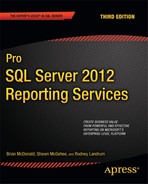Contents
![]() Chapter 1: Introducing the Reporting Services Architecture
Chapter 1: Introducing the Reporting Services Architecture
Understanding the Benefits of SSRS
SQL Server 2008 R2 and 2012 Reporting Services Enhancements
SSRS 2012 Integration with Microsoft Office SharePoint
Enhanced Charting and Report Item Visualizations
Enhanced Performance and Memory Management
SSRS and Business Intelligence
Business Intelligence Development Studio and SQL Server Data Tools
SQL Server Management Studio (SSMS)
Business Intelligence Development Studio (BIDS) and SQL Server Data Tools (SSDT)
![]() Chapter 2: Report Authoring: Designing Efficient Queries
Chapter 2: Report Authoring: Designing Efficient Queries
Introducing the Sample Relational Database
Knowing Your Data: A Quick Trick with a Small Procedure
Introducing Query Design Basics
Creating a Simple Query Graphically
Testing Performance with SQL Server Management Studio (SSMS)
Optimizing Performance: Dividing the Load
Using a Parameterized Stored Procedure
Using ISNULL to Evaluate the Parameters
![]() Chapter 3: Introduction to Reporting Services Design with SQL Server Data Tools
Chapter 3: Introduction to Reporting Services Design with SQL Server Data Tools
Exploring the Elements of BIDS
Understanding Report Definition Language (RDL)
Setting Up Data Sources and Datasets
![]() Chapter 4: Laying Out a Report
Chapter 4: Laying Out a Report
![]() Chapter 5: Implementing Dashboard-Style Report Objects
Chapter 5: Implementing Dashboard-Style Report Objects
Understanding the Chart Data Region
Creating a Report with the Report Wizard
Building the URL Link with a Report Parameter
Adding Hyperlink Formatting and Tooltips
Setting Report Parameters with Stored Procedures
Working with Multivalued Parameters
Configuring Report and Group Variables
![]() Chapter 7: Using Custom .NET Code with Reports
Chapter 7: Using Custom .NET Code with Reports
Using Embedded Code in Your Report
Using the ExceedMaxCosts Function
Using the ExceedMaxCost Function in a Report
Accessing .NET Assemblies from Embedded Code
Using Custom Assemblies with Your Report
Adding a Class Library Project to Your Reporting Solution
Adding an Assembly Reference to a Report
Using BIDS and Visual Studio 2012
Configuring Report Deployment Options
Setting Up Deployments Using the Configuration Manager
Deploying Reports Through the Solution Explorer
Using the Report Server Web Service
Allowing Users to Enter a Server Name
Populating the TreeView Control With a List of Folders
Opening the RDL File and Uploading It to the Server
![]() Chapter 9: Rendering Reports from .NET Applications
Chapter 9: Rendering Reports from .NET Applications
Report Server Command Parameters
Report Viewer Web Part Commands
Integrating SSRS 2012 with .NET Applications
Building a custom Report Viewer Using the WebBrowser Control
Building the Report Viewer Using a Report Viewer Control
Creating the Report’s Data Source
Using the Report Server Web Service
Web Services Method Categories
Creating the GetParameters Form
Coding the Report Parameters Form
Calling the Web Services GetItemParameters Method
Building the Report Viewer in ASP.NET
Exploring Management Roles in SSRS Deployment
Configuring a Report to Use a Shared Schedule
Updating and Uploading the RDL File Using Report Manager
Setting Up a Data Source for the Report
Creating Snapshots for the Report History
Processing Reports and Performing Caching
Managing Standard Subscriptions
Creating a Standard Subscription
Managing Data-Driven Subscriptions
Designing the Subscription Query
Creating the Data-Driven Subscription
Performing Execution Auditing and Performance Analysis
Transforming the ExecutionLog Table
Controlling SSRS Programmatically
Securing Network Traffic Using SSL
Setting Up Authentication and User Access to Data
Filtering Report Content with User!UserID
Setting SQL Server Permissions
![]() Chapter 12: Delivering Business Intelligence with SSRS
Chapter 12: Delivering Business Intelligence with SSRS
Building SSRS Reports for SQL Analysis Services
Using an Analysis Service Cube with SSRS
Setting Up the Analysis Services Data Source
Working with the Graphical MDX Query Builder
Incorporating SSRS with Microsoft SharePoint 2010
Installing SharePoint 2010 and SQL Server 2012 on a Stand-Alone Server
Installing SQL Server 2012 Reporting Services in SharePoint Mode
Installing and Starting the Reporting Services SharePoint Service
Creating a New Reporting Services Service Application
Configuring Reporting Services Integration with SharePoint
Deploying Reports in a SharePoint-Integrated SSRS Installation
Creating a Simple Dashboard to Display SSRS Reports
![]() Chapter 13: Creating Reports Using Report Builder 1.0, 2.0, and 3.0
Chapter 13: Creating Reports Using Report Builder 1.0, 2.0, and 3.0
Create a Report Model using BIDS 2008 R2
Creating Reports with Report Builder 1.0
Creating Reports with the Report Builder 2.0 Wizard
Creating Reports with Report Builder 2.0
